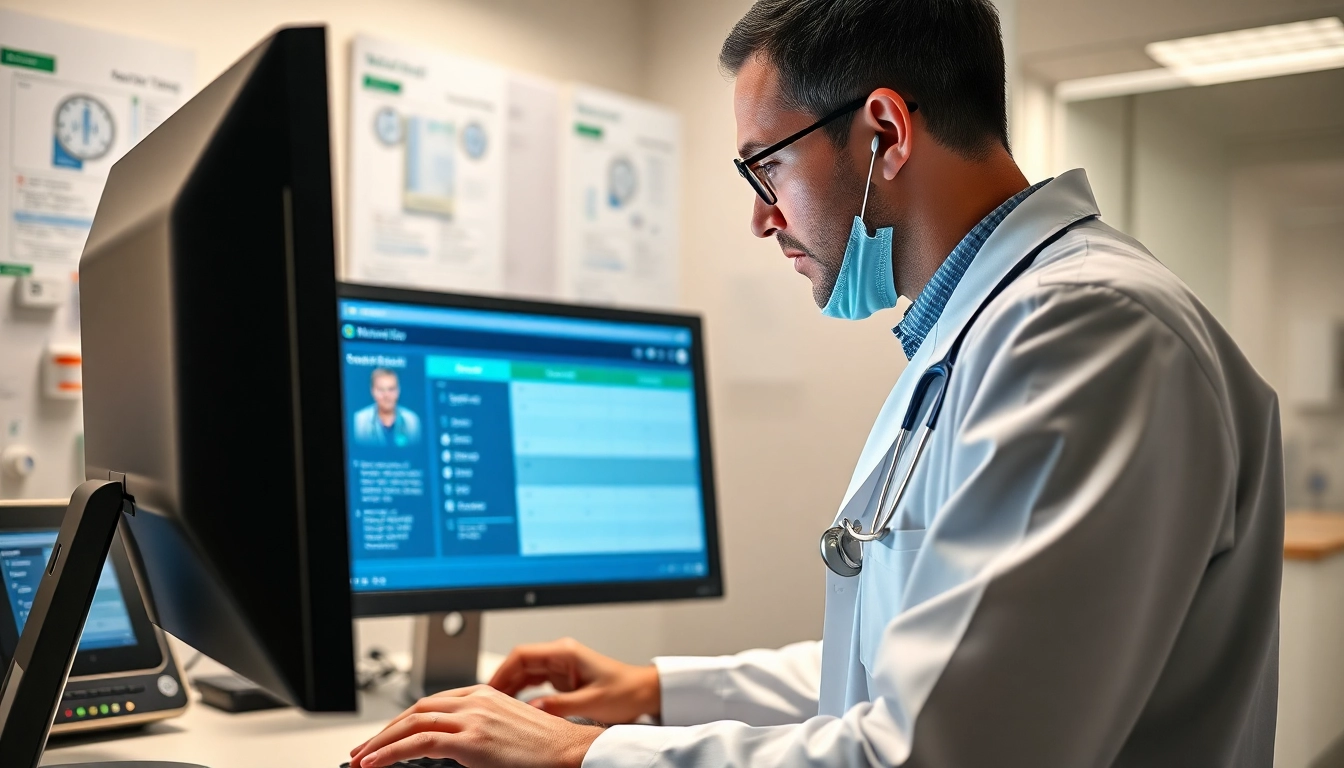Understanding E-Prescribing Software
What is E-Prescribing?
E-prescribing, or electronic prescribing, is a digital method for healthcare providers to send prescriptions directly to pharmacies or patients. This transition from traditional paper prescriptions helps streamline workflows and reduce errors associated with handwritten notes. It also enables real-time verification of patient medication records, ensuring safer outcomes and improved efficiency.
The utility of e-prescribing extends beyond basic prescription transfer; it encompasses functionalities such as medication history access, allergy checks, and formulary knowledge. With the modern eprescribing software, providers can easily prescribe medications electronically, thus reducing paperwork and facilitating quicker treatment delivery.
Core Features of E-Prescribing Software
At its core, e-prescribing software boasts several essential features that enhance its functionality for healthcare providers. These include:
- Prescription Management: Creating, modifying, and renewing prescriptions easily.
- Medication History: Access to a patient’s complete medication history helps prevent conflicts and adverse drug interactions.
- Allergy Checks: Alerts healthcare providers of any known allergies to avoid prescription errors.
- Drug Interaction Alerts: Notifications regarding potential drug interactions based on the patient’s current medications.
- Patient Profiles: Comprehensive profiles that include patient histories, including previous prescriptions and allergy status.
- Telehealth Integration: Compatibility with telehealth services, allowing for remote prescribing.
- Real-Time Prescription Benefit Checks: Information about insurance coverage and patient copays to guide prescribing choices.
Benefits over Traditional Prescription Methods
Transitioning from traditional prescription methods to e-prescribing presents numerous advantages:
- Increased Efficiency: Reduces the time spent on managing written prescriptions and minimizes follow-up calls to pharmacies.
- Improved Accuracy: Digital input reduces miscommunication and prevents errors associated with handwriting.
- Enhanced Patient Safety: Automatic checks and alerts promote safer prescribing practices.
- Better Patient Engagement: Patients have more access to their medication information, fostering autonomy in their health choices.
- Cost Savings: Reduces unnecessary hospital visits and adverse drug reactions that can arise from errors in traditional methods.
Implementing E-Prescribing Software in Your Practice
Steps for Successful Implementation
Adopting e-prescribing software requires a series of planned steps to ensure successful integration into clinical practices:
- Assess Current Practices: Evaluate existing prescription practices and the clinical environment to identify specific needs.
- Select Appropriate Software: Choose software that fits the requirements of your practice while offering usability and support.
- Plan for Technical Setup: Coordinate IT support for installation, integration, and data migration.
- Test Functionalities: Ensure that all features work as intended, including sending prescriptions to pharmacies.
- Train Staff: Develop training programs for staff to familiarize them with the e-prescribing system.
- Launch and Monitor: Once live, continuously monitor system performance and address any emerging issues swiftly.
Staff Training and Support
Effective training programs are crucial for the successful establishment of e-prescribing systems. Staff should undergo thorough training sessions that cover all functionalities of the software:
- Hands-On Demonstrations: Providing practical exercises can enhance understanding and confidence in using the software.
- Resource Availability: Ensure staff have access to reference materials, including user manuals and FAQs.
- Continuous Education: Plan ongoing training sessions following implementation to keep staff updated on any new features or updates.
Integrating with Existing Systems
The integration of e-prescribing software with existing Electronic Health Record (EHR) systems can enhance overall workflow and data sharing. Key factors in achieving seamless integration include:
- Compatibility Checking: Validate that the e-prescribing solution is compatible with current EHR systems and data formats.
- API Utilization: Employ Application Programming Interfaces (APIs) to foster communication between disparate systems.
- Testing Integration: Perform rigorous testing to ensure all systems operate correctly together before going live.
Exploring the Compliance and Security Aspects
HIPAA Compliance and Data Security
Compliance with the Health Insurance Portability and Accountability Act (HIPAA) is essential for any e-prescribing solution. It ensures the protection of patient data and enhances trust:
- Data Encryption: Ensure that all patient data transmitted is encrypted to prevent unauthorized access.
- Access Controls: Implement strict access controls, ensuring that only authorized personnel can access sensitive information.
- Regular Audits: Conduct regular audits to identify and rectify potential security vulnerabilities.
Staying Updated with Regulatory Changes
The healthcare landscape is continually evolving, and staying informed about new regulations is crucial. This can involve:
- Monitoring Regulatory Updates: Subscribe to industry news and alerts for updates from regulatory bodies.
- Engaging with Compliance Professionals: Consult with compliance experts to understand how new laws may affect e-prescribing practices.
Best Practices for Safe Prescription Practices
To optimize patient safety, healthcare providers should implement best practices such as:
- Standardized Terminology: Use consistent terminology to avoid misinterpretations.
- Regular Software Updates: Keep the software updated to mitigate any risk of security breaches.
- Patient Verification: Confirm patient identities before prescribing medications to ensure accuracy.
Evaluating Performance Metrics for E-Prescribing
Key Performance Indicators to Monitor
Monitoring performance metrics is vital for understanding the effectiveness of e-prescribing software:
- Prescription Error Rates: Track the number of errors in prescriptions before and after implementation.
- Prescription Completion Rates: Measure how many prescriptions are picked up by patients after being sent to the pharmacy.
- Workflow Efficiency: Assess changes in time spent on prescription management.
How to Measure Improvement in Patient Outcomes
Improved patient outcomes can be demonstrated through qualitative and quantitative metrics:
- Patient Satisfaction Surveys: Gather feedback on the ease and clarity of the prescribing process.
- Reduction in Hospitalizations: Monitor how e-prescribing affects emergency visits related to medication errors.
- Adherence Rates: Analyze whether patient adherence to prescribed treatments improves.
Feedback Mechanisms to Enhance User Experience
Creating channels for feedback helps continually refine the e-prescribing process. Strategies include:
- Surveys and Questionnaires: Implement regular surveys to gather user experiences and identify areas of improvement.
- Suggestion Boxes: Encourage staff to share their suggestions for improving the e-prescribing workflow.
Future Trends in E-Prescribing Technology
AI and Machine Learning in E-Prescribing
Artificial Intelligence (AI) and machine learning are set to revolutionize e-prescribing by enhancing predictive capabilities:
- Personalized Prescriptions: Use patient data to suggest personalized medication options based on historical preferences and responses.
- Predictive Analytics: Implement predictive analytics to identify patients at risk of non-adherence, enabling targeted interventions.
Integrating Telemedicine with E-Prescribing
The rise of telemedicine coupled with e-prescribing will create new avenues for patient care:
- Remote Consultations: Facilitate prescriptions with physicians consulting patients remotely, ensuring continuity of care.
- Streamlined Services: Enhance the integration of telehealth platforms with e-prescribing software for a seamless patient experience.
Looking Ahead: Innovations on the Horizon
The future of e-prescribing software indicates a more interconnected health ecosystem, driven by advancements in technology:
- Blockchain Technology: Utilize blockchain for secure data sharing, enhancing record accuracy and privacy.
- Wearable Device Integration: Allow e-prescribing solutions to interact with wearable health devices for more informed prescribing decisions.



